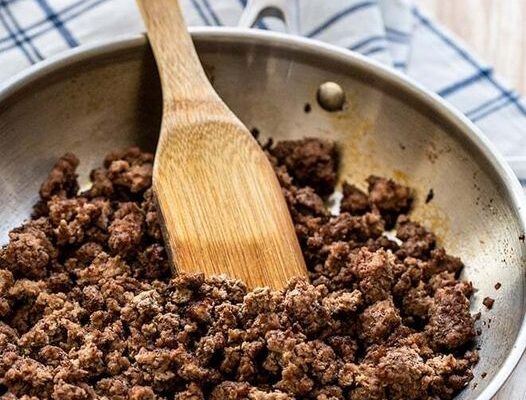Ground beef is a staple in many households, from juicy burgers to hearty casseroles. But have you ever wondered if you should rinse it before cooking? It’s a question that sparks heated debates in kitchens everywhere. Let’s dive into the facts and settle this once and for all.
The Common Practice: Washing Meat in General
Many people are taught to rinse meat before cooking to remove bacteria and impurities. This might seem like a logical step for safety, but when it comes to ground beef, things are a bit different.
Why People Rinse Ground Beef
The main reason some people rinse ground beef is to remove excess fat or blood. While this might seem like a good idea, there’s more to consider.
Bacteria Concerns
Some believe rinsing ground beef helps eliminate harmful bacteria like E. coli or salmonella. While the intention is good, the reality is much more complex.
The Science Behind It: Does Rinsing Help?
Rinsing ground beef might sound like a safety measure, but science tells a different story. In fact, it may do more harm than good.
Spreading Bacteria Around
When you rinse ground beef, the water can splash onto your kitchen surfaces, spreading bacteria to countertops, utensils, and other foods. This is called cross-contamination, and it can increase the risk of foodborne illness rather than reduce it.
Water Won’t Remove Bacteria
Surprisingly, rinsing won’t remove bacteria from ground beef. Cooking the beef to the correct temperature is the only effective way to kill harmful pathogens.
Does Rinsing Ground Beef Remove Fat?
Some people rinse ground beef in an attempt to reduce fat content. While rinsing may wash away some fat, there are better ways to achieve leaner meat.
Cooking Off Excess Fat
Instead of rinsing, you can cook ground beef and drain the fat from the pan. This method retains the beef’s flavor while significantly reducing fat.
Using Lean Ground Beef
Opting for lean or extra-lean ground beef is another effective way to cut fat without the need to rinse. These options have lower fat content from the start.
Rinsing Affects the Flavor and Texture
Believe it or not, rinsing ground beef can alter both its flavor and texture, leaving you with a less enjoyable meal.
Waterlogged Beef
When you rinse ground beef, you’re introducing extra moisture. This can lead to soggy, waterlogged beef that doesn’t brown properly during cooking. The result? A less flavorful dish.
Loss of Natural Juices
Ground beef has natural juices that contribute to its rich flavor. Rinsing strips away these juices, leaving you with a bland and less appealing texture.
What About Other Types of Meat?
While rinsing ground beef isn’t recommended, what about other meats? Is rinsing poultry or pork a good idea?
Rinsing Poultry
Rinsing chicken or turkey can also spread harmful bacteria like salmonella. As with ground beef, the best way to ensure safety is to cook poultry to the correct temperature.
Rinsing Pork
Pork is another meat that should not be rinsed. Any bacteria on pork will be killed during cooking, and rinsing only risks contamination.
How to Handle Ground Beef Safely
So if rinsing is out, how should you handle ground beef to keep your kitchen safe and your food delicious?
Proper Storage
Always store ground beef in the refrigerator and use it within a couple of days. If you’re not planning to use it right away, freeze it to preserve freshness.
Avoiding Cross-Contamination
Keep raw ground beef away from other foods. Use separate cutting boards, utensils, and wash your hands thoroughly after handling it.
Cooking Ground Beef to the Right Temperature
The most important safety tip when it comes to ground beef? Cook it to the right temperature.
The Magic Number: 160°F
Ground beef should be cooked to an internal temperature of 160°F (71°C). This ensures that harmful bacteria are eliminated, making your meal safe to eat.
Using a Meat Thermometer
A meat thermometer is the best tool for checking doneness. It takes the guesswork out of cooking and ensures your beef is perfectly cooked every time.
Alternatives to Rinsing Ground Beef
If your goal is to remove fat or impurities from ground beef, there are better alternatives than rinsing.
Draining the Fat
After cooking ground beef, drain off the excess fat by tilting the pan or using a colander. This method is quick, easy, and doesn’t affect the flavor or texture.
Blotting with Paper Towels
Another method to remove fat is blotting the cooked beef with paper towels. This absorbs the extra grease without compromising the taste.
Conclusion
When it comes to ground beef, rinsing is not only unnecessary – it can be risky. Instead of washing away bacteria, rinsing spreads it around your kitchen and dilutes the flavor of your meat. The best way to ensure ground beef is safe and delicious is to handle it properly, cook it to the right temperature, and drain off excess fat after cooking. So next time you’re prepping ground beef, skip the rinse and focus on what really matters: safe cooking practices and preserving that rich, meaty flavor.
